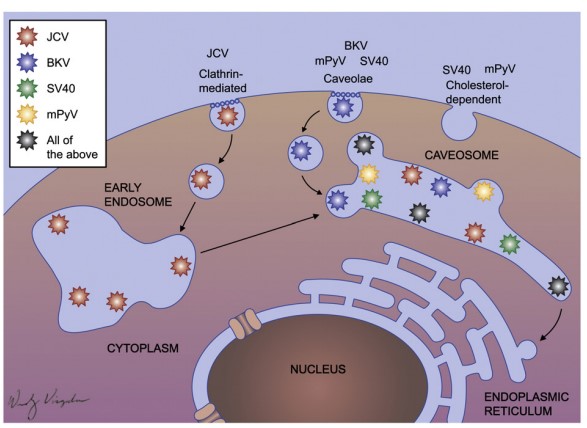Mempro™ Polyomaviruses for Virus-like Particles (VLPs)
Based on the comprehensive Virus-like particles (VLPs) platform established through years of experience, scientists from Creative Biostructure can offer tailored Mempro™ VLPs derived from polyomaviruses using VLPs platform.
VLPs are multiprotein nanostructures or multiprotein formed from viral structural proteins, but don’t contain any viral genomes. These spontaneously occurring bionanomaterials usually simulate the conformation of real viruses. VLPs has mehrmals, high density exhibition of viral surface proteins provided conformational viral epitopes which can cause strong T cell and B cell immune responses. Therefore, VLPs are ideal candidates for vaccines production.
Polyomaviruses are abroad spread viruses in nature which were recognized as a virus family in 2006. They are small nonenveloped DNA viruses and remain latent after primary infection in immunocompetent hosts. In addition, several polyomaviruses are connected with human disease, even a number of them are oncoviruses which enable to cause tumors.

Fig. 2. General model of infectious entry pathways utilized by polyomaviruses.(virology 2008)
- Genome Structure of Polyomaviruses
Polyomaviruses are double-stranded DNA viruses with a nearly 5000 base pairs genome. The viral genome is wrapped in a capsid of about 40-50 nanometers in diameter, which is icosahedral in shape. 72 pentamers of the VP1 protein form the capsid, each molecule of VP1 is related to one of the other two capsid proteins, VP2 or VP3. The genome of a classic polyomavirus codes for between 5 and 9 proteins, according to the time during infection in which they are transcribed they can be divided into two transcriptional regions: the early and late regions. The small and large tumor antigens are generally coded by the early regions, which are formed by splicing. Three capsid structural proteins VP1, VP2, and VP3 are produced by the late region.
- Infection of Polyomaviruses
John Cunningham virus (JCV) is a type of human polyomavirus. Nearly 80% of adults all over the world reveal serologic proof of JCV infection, a majority of them without any clinical manifestations or past records of JCV disease. One feasible approach to transmit is contaminated food or water, while others have not been definitively established. JCV keeps potential in the urogenital tract, brain and lymphocytes of its host, therefore, they possible reactivate to lead to disease in immunocompromised hosts.
Creative Biostructure has been pioneered in the VLPs research for a long time, the team of Creative Biostructure can offer unparalleled service of Mempro™ VLPs derived from polyomaviruses based on the VLPs platform. Please feel free to contact us for a detailed quote.
References:
Santi L, Huang Z, Mason H. Virus-like particles production in green plants[J]. Methods, 2006, 40(1): 66-76.
DeCaprio J A, Garcea R L. A cornucopia of human polyomaviruses[J]. Nature reviews Microbiology, 2013, 11(4): 264-276.
Gossai A, Waterboer T, Nelson H H, et al. Seroepidemiology of human polyomaviruses in a US population[J]. American journal of epidemiology, 2015: kwv155.
Kean J M, Rao S, Wang M, et al. Seroepidemiology of human polyomaviruses[J]. PLoS Pathog, 2009, 5(3): e1000363.